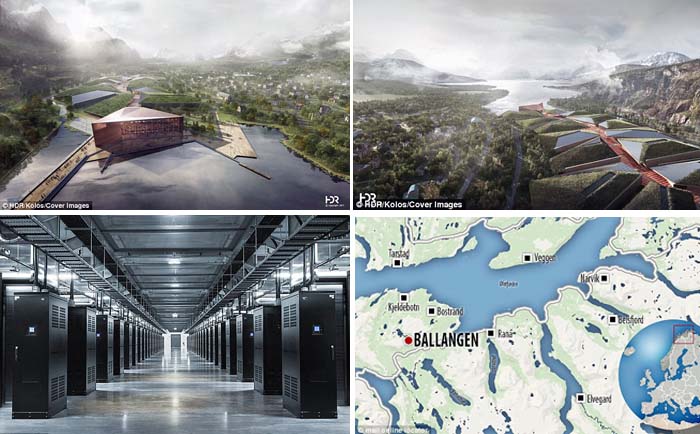Pusat Data Terbesar Dunia Andalkan Angin dan Air Kolos untuk Sistem Pendingin
World`s Largest `Fortress for Data` is Being Built in the Arctic
Editor : Ismail Gani
Translator : Novita Cahyadi

BENTENG terbesar di dunia 'data' sedang dibangun di Arctic, dan akan didukung oleh energi berkelanjutan 100 persen.
Terletak di pinggiran utara Norwegia, Kolos akan menjadi pusat data hijau terbesar di dunia - bergantung sepenuhnya pada tenaga air dan angin.
Iklim yang sejuk dan stabil di utara Norwegia dan kedekatan lokasi dengan air akan memberikan pendinginan alami bagi server-server raksasa di tengahnya.
Perusahaan internet seperti Facebook menggunakan 'server farm' besar seperti ini, untuk menyimpan dan mengelola data.
Peralatan komputer berdaya listrik tinggi menghasilkan sejumlah besar panas sehingga sebagian besar pusat data menggunakan sistem chiller agar tetap dingin.
Negara-negara Nordik sekarang menawarkan lahan mereka untuk pusat server dengan dasar pemikiran bahwa lokasi dingin mereka akan membantu peralatan komputer tetap dingin.
Pusat server tersebut akan dipadati rak-rak berukuran besar untuk server data seperti foto.
"Kolos akan secara canggih memaksimalkan energi hijau dan fitur geografis unik dari Norwegia utara untuk memberikan layanan pusat data yang paling efisien," dalam pernyataan resmi Kolos.
Pusat data ini dibangun di dekat kota pertambangan Ballangen di Norwegia.
Sejauh ini, mitra desain arsitektur Kolos HDR telah mengungkap seperti apa lokasi pusat data tersebut.
"Karena pusat data menghadapi pengawasan yang meningkat untuk konsumsi daya dan jejak karbon yang besar, Kolos akan memimpin perubahan sektor ini menjadi energi hijau, membantu perusahaan dan brand mendukung upaya dunia untuk beralih ke energi terbarukan," kata perusahaan itu.
Perusahaan berencana untuk beroperasi pada pengurangan biaya energi sebesar 60 persen - yang diklaim akan menjadikannya sebagai pusat data yang paling kompetitif di dunia.
'Kolos akan menerapkan teknologi terbaru dalam keamanan pusat data, menggunakan insinyur dan pakar teknologi paling inovatif, yang akan terus memantau dan mengelola risiko keamanan cyber baru-baru ini, kata perusahaan itu.
'Selain itu, Kolos dikelilingi oleh air dan perbukitan, menyediakan parit alami untuk melindungi dari risiko fisik apapun. Kolos akan menjadi benteng untuk data," kata mereka.
Pengembang mengatakan bahwa pusat tersebut akan secara langsung menciptakan 2.000 hingga 3.000 pekerjaan baru dan mendukung 10.000 hingga 15.000 pekerjaan yang ada di komunitas Ballangen.
Pada 2009 Google membeli pabrik kertas di Hamina, Finlandia selatan, dan mengubahnya menjadi pusat data, menggunakan air laut dari Laut Baltik untuk sistem pendinginannya.
Server di dalam pusat data merupakan tulang punggung layanan internet seperti Facebook.
Mereka menyimpan dan mengirimkan miliaran update status, tautan, foto dan semua aplikasi luar yang digunakan oleh anggota Facebook.
Tahun lalu Mark Zuckerberg memberi gambaran langka di dalam salah satu pusat server rahasia Facebook.
Terletak jauh di dalam hutan di Swedia utara, pusat data Lulea dibuka pada 2013, dan merupakan tempat pertama Facebook di luar AS.
Selusin pembangkit listrik tenaga air beroperasi di sungai terdekat, menyediakan sumber daya yang andal dan terbarukan.
Seluruh sistem ini 10 persen lebih efisien dan menggunakan daya hampir 40 persen lebih sedikit daripada pusat data tradisional, klaim Facebook seperti dilansir MailOnline.
THE WORLD'S largest 'fortress for data' is being built in the Arctic, and it will be powered by 100 per cent sustainable energy.
Located in the northern fringes of Norway, Kolos will be the largest green data centre in the world - relying entirely on hydropower and wind.
The cool, stable climate of northern Norway and the site's proximity to water will provide natural cooling for the centre's vast servers.
Internet companies such as Facebook use huge 'server farms' such as this, to store and manage data.
High-power computer equipment generates huge amount of heat so most data centres use chiller systems to stay cool.
Nordic countries now sell plants on the basis that their frosty locations will help cool computer equipment.
The plants are filled with cupboard-sized racks of computer servers that store and move data such as photos.
'Kolos will intelligently maximise green energy and the unique geographic features of northern Norway to deliver the most efficient data centre services,' said a Kolos company statement.
The centre is being built near the Norwegian municipality of Ballangen.
So far, Kolos' architecture design partner HDR has created renders of what the site will look like.
'As data centres face increasing scrutiny for their heavy power consumption and large carbon footprint, Kolos will lead the sector's shift to green energy, helping companies and brands support the world's efforts to transition to renewable energy', the company said.
The company plans to operate at a 60 per cent reduction in energy costs - which it claims would make it the most competitive data centre in the world.
'Kolos will deploy the latest technology in data centre security, employing the most innovative engineers and technology experts, who will constantly monitor and manage new cyber-security risks, the company said.
'Additionally, the Kolos site is surrounded by water and hills, providing a natural moat to protect against any physical risks. Kolos will be a fortress for data', they said.
Developers say the centre will directly create 2,000 to 3,000 new jobs and support 10,000 to 15,000 existing jobs in the community of Ballangen.
In 2009 Google purchased a paper mill in Hamina, southern Finland, and turned it into a data centre, using seawater from the Baltic Sea for its cooling system.
Servers inside data centres are the backbone of Internet services such as Facebook.
They store and transmit billions of status updates, links, photos and all the outside apps used by Facebook's members.
Last year Mark Zuckerberg gave a rare glimpse inside one of Facebook's secretive server farms.
Located deep in the forests of northern Sweden, the Luleå data center opened in 2013, and was Facebook's first outside the US.
A dozen hydro-electric plants operate on nearby rivers, providing a reliable and renewable power source.
The whole system is 10 per cent more efficient and uses almost 40 per cent less power than traditional data centres, Facebook claims.















